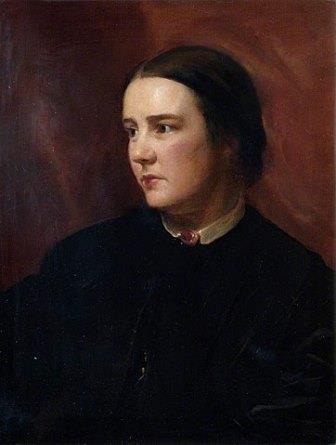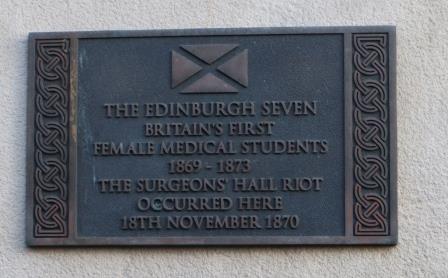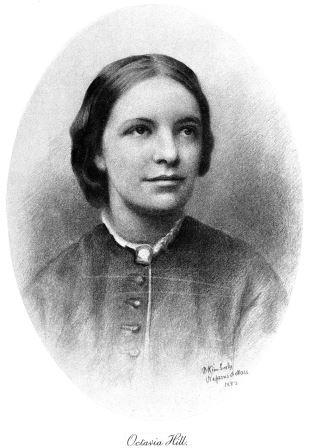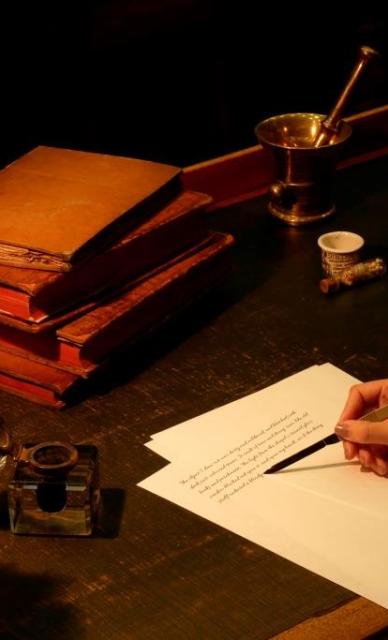Physicians' Gallery Newsletter
Updates on upcoming events, exhibitions and online stories
Empowering medical excellence, shaping healthcare futures.
Dr Sophia Jex-Blake (1840 – 1912) was a trailblazer. She fought hard for women’s rights and was a pioneer of social change from within the medical field. In 1869, she published her famous essay Medicine as a Profession for Women and shortly after applied to the University of Edinburgh to study medicine. Her application was rejected on the basis that the University “could not bend the rules for one woman.”

She placed advertisements in newspapers and recruited six other women to join her in applying. The group became known as the “Edinburgh Seven.” The University accepted the group’s applications, and they became the first women to study at any British university. Unfortunately, the women were not awarded degrees after the notorious Surgeons Hall Riot of 1870 (where over 200 male pupils violently protested the women who were there to sit an anatomy exam.) The riot threatened the University’s reputation, not for the violent actions of the male students, but for their controversial admittance of the women into the Medical School. The University caved to pressure and did not allow the seven women to graduate. Though the women challenged this, the University won the court case.
This did not stop Sophia, for in 1874 she helped establish the London School of Medicine for Women and in 1877 she was awarded her M.D. by the University of Berne. The same year, she got her medical license with the King’s and Queen’s College of Physicians of Ireland and became the third woman to register as a doctor with the General Medical Council.
In 1886, she established the Edinburgh School of Medicine for Women. Though the school closed in 1892, that same year the University of Edinburgh finally began again to admit women as students.
Sophia retired in 1899 and moved to a village in Southeast England where she lived on a small farm with her longstanding companion and former pupil Dr Margaret Todd (1859-1918). She lived there until her death in 1912. Six years later, Todd published a detailed biography The Life of Dr Sophia Jex-Blake.

The Life of Dr Sophia Jex-Blake is the authoritative source on Sophia’s life. After publishing, Margaret burned all of Sophia’s papers (and her own) according to instructions left in her will. Luckily, Margaret spares the reader no details in narrating Sophia’s achievements and relationships. However, it is interesting that she gives no mention of herself despite being such a big part of her life.

One relationship in particular that Margaret spotlights is the short-lived, intense, affair between Sophia and Octavia Hill (1838-1912). We are told that the two women met in January 1860 and quickly became friends. By May, they had gone on a trip to Hurst where Sophia writes in her diary: “(she) sunk her head on my lap silently, raised it in tears, and then such a kiss!” Shortly after, against the wishes of her parents, Sophia moved in with the Hill family. Whilst she was away briefly in December Octavia wrote to her “I wander like a lost thing about the house and long for you intensely.” Margaret comments: “here, one would have said, was the beginning of an ideal friendship […] had the two girls been alone in the world.” It is comments like these that amp up the dramatic and romantic nature of their relationship whilst also hinting to Margaret’s perspective and anecdotal knowledge.
In 1861, after a period of absence, Octavia writes to Sophia that upon her return she held herself prepared to “be given strength to do my duty, but certainly not longing for anything that will bring me again into a world of contention.” When she came back to the house, Octavia ended the relationship. Again, Margaret’s comments heighten the drama: “it was no rupture. It was a nightmare, an inexplicable darkness at noonday.” However, she is merely mirroring the emotion felt in Sophia’s own words (and, it is likely that Sophia recounted the story many times over the years to Margaret.) She wrote in her diary at the time:
“it is curious how the whole fashion of my life shapes itself with the arrière-pensée of being ready for her ‘at midnight or cock-crowing or in the morning’ […] – making the most of the working time now that a pause of rest may fall due whenever she comes to claim the ‘moon”’
Dating or not, Sophia was heartbroken by the break. She never lost hope that the relationship would one day be restored (though it never was). Margaret describes the break’s impact like a divorce or even a death: “till the close of her life the friendship on her side remained unbroken […] Octavia Hill became to S.J.-B a pure ideal.” Again, telling the reader something that only someone with a personal close relationship to Sophia would know – a relationship that never gets a mention.
There was a change in attitude towards relationships such as Sophia and Octavia’s, those that were “romantic friendships,” that happened at the turn of the century. Though their relationship was explicitly romantic it was not too far outside of the bounds of what was socially acceptable for Victorian women. It was not seen as homosexual behaviour. By the time the biography was published however, lesbianism was generally considered to be a mental illness by the medical community and general public. The nature of two educated unmarried women such as Margaret and Sophia working in a “masculine” environment and living together would have been seen as increasingly suspicious during this time. This fact goes a long way towards understanding why it was safe enough to describe Sophia and Octavia’s relationship the way she does and why Margaret never mentions herself in the biography.
Though Margaret destroyed her own papers, leaving very little known of her own life, she contributed a great deal to telling the stories of strong, unconventional, medical women in both fact and fiction. American professor of English literature Kristine Swenson has done extensive research into Sophia and Margaret suggests that Margaret’s autobiography can be found within these stories.

In 1892, Margaret published the three-volume fictional novel Mona Maclean, Medical Student (under the male pseudonym Graham Travers) which is generally considered to be autobiographical and radical in its storytelling. Swenson, describes the novels as “proto-lesbian fiction” and has cross-referenced them to Sophia’s biography and found uncanny similarities between the characters and people from Sophia’s life. It is not unlikely, as Sophia’s student, that the stories take inspiration from both of their lives. However, as Swenson says, Margaret would have felt the pressure of impersonal professionalism when writing the biography because of its importance within the medical field. She writes, “the entire campaign to admit women to medical training and practice hinged upon women displaying a professionalism that could be separated from their “natural” sexual disadvantages.” Here, we see Margaret two vocations overlapping whilst also at odds with each other, her writing giving way to her medical practice.
The stories that exist, both Mona and Sophia, reveal what life was like for a woman in the changing medical world of the late 19th century. The untold story, Sophia and Margaret’s, perhaps tells us what it was like for women who were queer, or at least those that could have appeared to be, during that time.
Sophia Jex-Blake led by example. She believed that women should have equal rights to go to university, to become doctors, and so she pioneered that change. She didn’t believe in marriage, and so she did not marry. She did not dress or behave or comply in the ways that society expected; she was as Margaret described her: “dogged,” “high handed,” with a “disregard of tradition” and an “actual – if superficial – roughness.” Is it any wonder that the queer medical community today want to claim her for their own? In some ways she already has been (a quick google of her name and the second result is a recent article championing Sophia as “queer”.)
The bottom line is that we cannot say for sure one way or the other. We cannot ask Sophia and so we cannot “out” her. What we can say for sure, is that she was true to her beliefs, and as strongly as Sophia believed that medicine was a profession for women, I’m sure that she would agree it is also a profession for queer women.
Written by Rachel Howarth who identifies as queer and recently received her MA in Fine Art from the University of Edinburgh.
References and Further Reading:
- Carter, Alexandra K. “Queer Women in the History of Medicine: Sophia Jex-Blake and Women’s Medical Education in Victorian Britain.” University of Toronto Library.
https://fisher.library.utoronto.ca/fisher-blog/queer-women-history-medi…
- Todd, Margaret Georgina. Mona Maclean, Medical Student, 3 vols. Edinburgh: Blackwood, 1892.
- Todd, Margaret Georgina. The Life of Sophia Jex-Blake. London: Macmillan, 1918.
- Swenson, Kristine. “Intimate Sympathy and Self-Effacement: Writing the Life of Sophia Jex-Blake.” A/b: Auto/Biography Studies 14, no. 2 (1999): 222–40.
- University of Oxford. “Margaret Todd (1859-1918): Medical woman and author.”
https://conscicom.web.ox.ac.uk/article/margaret-todd-1859-1918-medical-…
- https://www.undiscoveredscotland.co.uk/usbiography/j/sophiajexblake.html
Image Sources:
1. Sophia Jex-Blake’s portrait by Samuel Laurence, 1865. Published in The Life of Sophia Jex-Blake by Margaret Todd.
2. The Edinburgh Seven plaque on Surgeon’s Hall. The Royal College of Physicians Edinburgh.
3. Undated image of Octavia Hill from Life of Octavia Hill as told in her letters / Edited by C. Edmund Maurice. Copyright The Wellcome Collection (https://wellcomecollection.org/search/images?query=nbyh2bm8#)
4. Mona Maclean Medical Student by Margaret Todd. The Royal College of Physicians Edinburgh.
5. Scan of an image of Margaret Todd from the National Book League (Great Britain) Book News, vol 20, number 240, page 939.

Updates on upcoming events, exhibitions and online stories